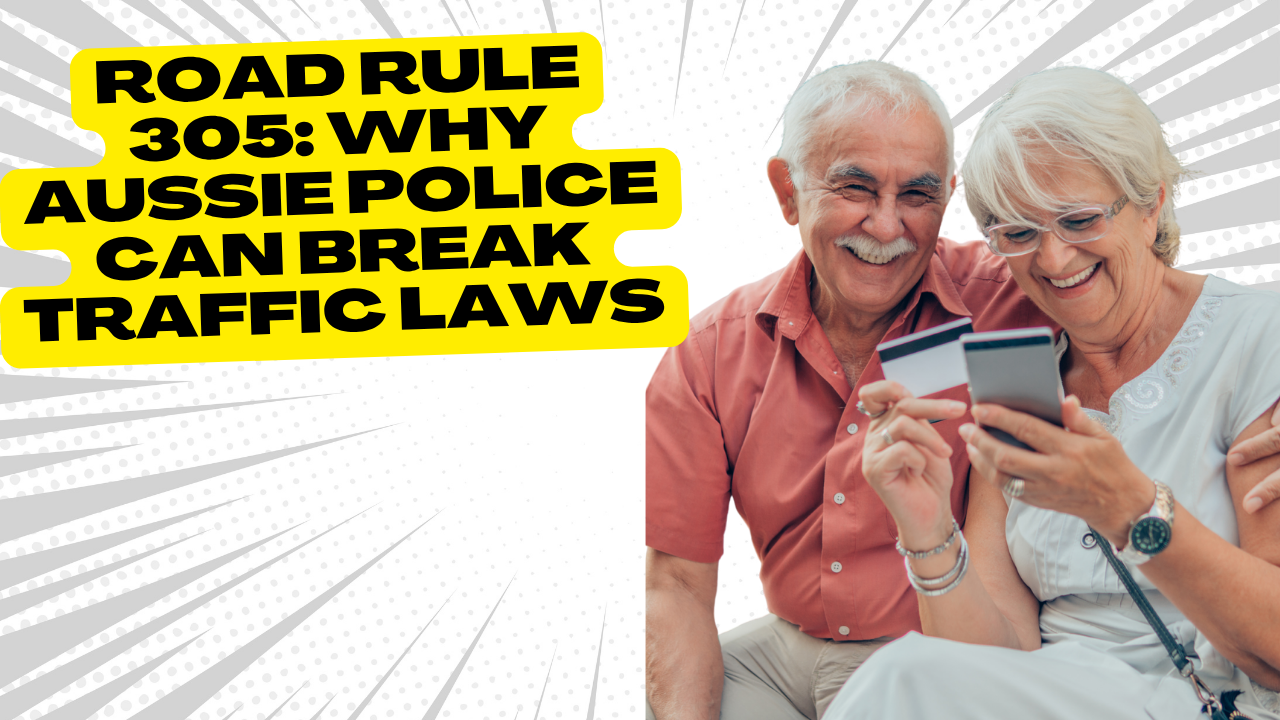In Australia, road rules are the backbone of safe and orderly driving, ensuring that millions of motorists navigate the country’s roads without chaos. However, one group of road users—police officers—operates under a unique set of privileges that allow them to bypass certain traffic regulations. This is governed by Road Rule 305, a provision within the Australian Road Rules that grants police exemptions from specific traffic laws under certain circumstances. While these exemptions are critical for enabling law enforcement to perform their duties effectively, they have also sparked debate about accountability, safety, and potential misuse. This article delves into the details of Road Rule 305, exploring why police are allowed to “break” traffic laws, the legal framework behind it, the conditions that must be met, and the broader implications for Australian society.
What is Road Rule 305?
Road Rule 305 is a provision in the Australian Road Rules, a model framework established in 1999 by the National Transport Commission (NTC) to harmonize road regulations across Australia’s states and territories. While each state and territory adapts these rules slightly, Rule 305 consistently applies to police vehicles nationwide, with minor variations in places like the Australian Capital Territory (ACT) and Queensland. The rule states that a provision of the Australian Road Rules does not apply to the driver of a police vehicle if:
-
Reasonable Care is Taken: The driver must exercise reasonable care in the circumstances.
-
Reasonableness of Exemption: It must be reasonable for the rule not to apply given the situation.
-
Warning Signals (if applicable): If the police vehicle is moving, it must display a blue or red flashing light or sound an alarm, unless it is reasonable not to use these signals or the vehicle is not equipped with them.
This rule effectively allows police officers to disregard certain traffic regulations—such as speed limits, red lights, or U-turn restrictions—when necessary to carry out their duties, provided they adhere to the above conditions. For example, a police officer chasing a fleeing suspect or responding to an emergency may exceed the speed limit or drive through a red light, but they must do so with caution and, typically, with lights and sirens activated.
Why Do Police Need These Exemptions?
The exemptions under Road Rule 305 are not a blank check for police to drive recklessly; they serve a critical purpose in enabling law enforcement to protect public safety. Here are the key reasons why these exemptions are necessary:
1. Emergency Response
Police officers often need to respond quickly to emergencies, such as crimes in progress, accidents, or public safety threats. Delays caused by adhering to standard traffic rules could result in loss of life, injury, or failure to apprehend a suspect. For instance, an officer rushing to a reported armed robbery needs to arrive swiftly to neutralize the threat, which may require speeding or navigating through intersections against traffic signals. The use of lights and sirens warns other road users, minimizing the risk of collisions.
2. Pursuit of Suspects
High-speed pursuits are a classic example of when Road Rule 305 comes into play. If a suspect flees in a vehicle, police may need to exceed speed limits or make maneuvers that would otherwise be illegal to keep up. These situations are inherently risky, which is why the rule emphasizes “reasonable care” and the use of warning signals to alert other drivers and pedestrians.
3. Undercover Operations
In some cases, police vehicles—particularly unmarked ones—may not use lights or sirens to avoid detection during covert operations. Rule 305 accounts for this by allowing exemptions even without warning signals if it is reasonable for the vehicle not to be equipped with them or for the signals to remain off. For example, an undercover officer tailing a suspect may need to discreetly disregard a traffic rule to maintain surveillance without alerting the target.
4. Public Safety and Flexibility
The broad wording of Rule 305 provides flexibility for police to act in dynamic, unpredictable situations. Whether it’s escorting a dignitary, securing a crime scene, or responding to a natural disaster, the exemptions ensure officers can prioritize public safety over strict adherence to traffic laws. As a Victoria Police spokesperson noted, these exemptions are “absolutely necessary” to keep communities safe, provided officers exercise reasonable care.
Legal Framework and Conditions
While Road Rule 305 grants exemptions, it is not a free pass. The conditions attached to the rule ensure that police officers remain accountable and prioritize safety. Let’s break down the key requirements:
Reasonable Care
The requirement to take “reasonable care” is central to Rule 305. This means that even when breaking traffic laws, police must drive in a way that minimizes risk to themselves and others. For instance, speeding through a busy intersection without lights or sirens would likely be deemed unreasonable unless exceptional circumstances justified it. Each instance is judged on its merits, and officers must balance the urgency of their task with public safety.
Reasonableness of Exemption
The rule only applies if it is reasonable for the traffic law to be disregarded. This subjective criterion depends on the context. For example, it may be reasonable to speed to catch a dangerous driver but not to rush to a non-urgent call. This condition ensures that exemptions are not abused for convenience or minor tasks.
Warning Signals
When a police vehicle is moving, Rule 305 typically requires the use of blue or red flashing lights or an alarm (siren) to warn other road users. This is why police cars in emergency situations are often seen with lights flashing and sirens blaring. However, the rule allows exemptions without signals if it’s reasonable—for example, in covert operations or if the vehicle lacks such equipment.
State Variations
While the Australian Road Rules provide a uniform framework, states like Queensland and the ACT have slight variations. In Queensland, police are subject to the same laws as other drivers regarding driving under the influence, meaning Rule 305 does not exempt them from DUI laws. In Victoria, additional provisions like Rule 305A extend exemptions to police driver training scenarios. These variations reflect local priorities but maintain the core principles of the rule.
Controversies and Criticisms
Despite its necessity, Road Rule 305 has faced criticism for its broad scope and potential for misuse. Some argue that the exemptions give police too much leeway, potentially endangering the public. For instance, a Victorian police officer faced charges for speeding and reckless driving, highlighting that exemptions do not shield officers from accountability if their actions are deemed unsafe or unjustified.
Public Safety Concerns
High-speed pursuits, in particular, have drawn scrutiny. While Rule 305 allows police to chase suspects, these pursuits can lead to accidents involving officers, suspects, or bystanders. Critics argue that the risk to public safety sometimes outweighs the need to apprehend a suspect, especially for non-violent offenses. In response, police forces like the NSW Police emphasize their Safe Driver Policy, which includes regular training and assessments to ensure officers drive responsibly.
Perceived Double Standards
Another point of contention is the perception that police are “above the law.” Regular drivers face hefty fines and demerit points for speeding or running red lights, yet police can do so under Rule 305. This disparity can erode public trust, especially when exemptions are used in non-emergency situations. For example, an officer speeding to a routine call without lights or sirens could be seen as abusing their privileges, even if technically within the law.
Lack of Transparency
Determining whether an officer’s actions were “reasonable” is often subjective and assessed internally by police or in court after an incident. This lack of transparency can fuel public skepticism, particularly when accidents occur. Critics call for stricter oversight, such as mandatory reporting of exemption use or independent reviews of police driving incidents.
Balancing Act: Safety vs. Duty
Road Rule 305 embodies a delicate balance between enabling police to perform their duties and ensuring public safety. Police forces across Australia undergo rigorous training to handle high-pressure driving situations, and policies like the NSW Safe Driver Policy aim to reinforce responsible use of exemptions. However, the rule’s flexibility is both its strength and its weakness. It allows officers to adapt to unpredictable scenarios but also opens the door to subjective interpretation and potential misuse.
Training and Accountability
To mitigate risks, police are trained in advanced driving techniques, including how to safely navigate intersections, manage high speeds, and avoid collisions. In cases where officers violate Rule 305’s conditions—such as driving recklessly without justification—they can face disciplinary action, fines, or even criminal charges, as seen in the Victorian case mentioned earlier.
Public Awareness
Educating the public about Rule 305 can help bridge the gap between perception and reality. Many drivers are unaware of the conditions attached to police exemptions, leading to misunderstandings about why officers can “break” traffic laws. Clear communication from police and government agencies could reduce resentment and clarify that these exemptions exist to serve the public, not to privilege officers.
In Summary
Road Rule 305 is a vital component of Australia’s road safety framework, allowing police to bypass certain traffic laws to protect communities and respond to emergencies. By requiring reasonable care and, in most cases, the use of warning signals, the rule ensures that exemptions are not a license for reckless driving. However, its broad scope and subjective criteria have sparked debate about accountability and public safety. Striking the right balance requires ongoing training, transparent oversight, and public education to maintain trust in law enforcement. As Australia continues to refine its road rules, Rule 305 will remain a critical—yet contentious—tool in the police arsenal.

